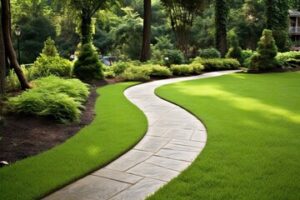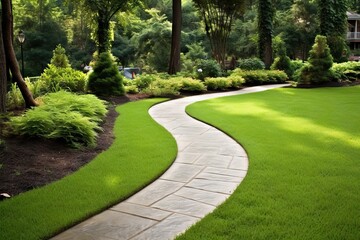Landscape design is about more than just mowing the lawn or planting flowers. It’s about framing the house, providing a place to entertain family and friends, or simply creating a peaceful retreat.
Start with a small project and work your way up to a larger one. This will help you gain experience and build confidence in your DIY landscaping skills. Visit Website to learn more.
A healthy, lush lawn adds curb appeal and value to your home. It also promotes a healthy environment for your family and pets.
The key to a healthy lawn is consistent care. Services like mowing, fertilization, aeration, and pest and weed control are all necessary for maintaining a healthy landscape. However, doing all of these tasks yourself can be time consuming and difficult. It can also be difficult to keep up with the changing seasons and their lawn care needs.
Adding soil amendments is another important component of lawn maintenance. These materials improve soil texture and increase nutrient availability. Amendments can be applied based on the results of a soil test. This test tells you if your soil is sandy or clay, as well as the pH level and salt content.
Watering is another essential part of lawn maintenance. Proper watering involves deep and infrequent irrigation, which promotes root growth and reduces evaporation. Mowing at the appropriate height for your grass type is also critical.
Weeds are another common problem in residential lawns. They compete with grass for sunlight, water, and nutrients. They also clog drainage ditches, which can lead to erosion. Weeds can be controlled using a variety of methods, including weed killers and hand pulling.
Disease pressure can also be a serious issue in residential lawns. In some climatic conditions, diseases such as dollar spot, brown patch, rust, and stripe smut can devastate healthy turf. A lawn care professional can help you choose the best treatment options for your lawn.
A professional lawn care service can keep your lawn healthy and beautiful all year round. In addition to routine mowing and fertilization, your service can include services such as aeration, weed control, and seasonal care.
Watering
Water is one of the most important aspects of landscaping. It is a key part of the process that helps plants to create energy through photosynthesis. Without enough water, plants will die because they cannot access the nutrients in the soil and the air.
It is also a key component for maintaining the health and beauty of your landscape. However, it is important to do this in a way that prevents damage to your plants and soil. For example, over-watering can be just as damaging as not watering enough. It is best to water your landscape in the morning, rather than at night, and to do it slowly and thoroughly. This will help to reduce the risk of fungal infections and will keep your soil healthy and hydrated.
Water conservation is an important aspect of landscaping and can be achieved through the right plant selection, efficient irrigation systems, and proper soil preparation. This approach can be used to create a beautiful, thriving, low-maintenance landscape that is both environmentally sustainable and affordable. In addition, many cities and counties offer rebates on irrigation controllers, rain barrels, and water-efficient toilets and showerheads that can further help homeowners to save money and conserve this precious resource.
The final element of landscaping is water features, which add visual interest and can be a relaxing oasis for homeowners to enjoy. These include ponds, streams, waterfalls, and fountains. These elements are essential for creating a landscape that is both visually appealing and functional, and they should be maintained properly to ensure that they are safe for users and to avoid pollution. Water features are a great addition to any outdoor space and can boost property value.
Fertilizing
Almost everything that your landscape plants need to survive and thrive, from moisture uptake to root spread, flowering and fruiting, depends on the nutrients in the soil. As the plants in your garden and yard grow, however, those nutrients become depleted, and they need to be replenished. This is the purpose of fertilizing.
Fertilizers are organic or inorganic products that are added to the soil or to a plant to add important minerals and nutrients. A fertilizer contains the nutrients that are used by a plant most often, such as nitrogen (N), phosphorus (P) and potassium (K). A fertilizer can be made from a variety of substances, including manure, decomposed plant material, grass clippings or synthetic materials produced in a factory. There are also a number of different methods for applying fertilizers, including broadcasting dry types or spraying liquid types. The best time to apply a fertilizer, however, depends on the type of plant and its individual needs.
For example, it is best to fertilize grass in late summer through September, because this is when the roots are most active and able to absorb the nutrients that they need. In contrast, it is best to apply fertilizer to woody plants, like trees and shrubs, in early spring before they begin their annual growth.
The timing of fertilizing may seem complicated, but a professional maintenance team can track the growth of your landscape to make customized recommendations for the best times to apply fertilizer. For example, certain plants known as heavy feeders, such as roses and dense vegetables, require frequent fertilization to keep them healthy and vigorous. Other plants need to be fertilized less frequently, such as lawns and perennials.
Weed Control
Weeds are unwanted plants that compete with desired plantings for sunlight, water and nutrients. They may also interfere with soil erosion and provide habitat for pests. Weeds are commonly found in lawns, but they can also be a problem in landscape planting beds, woodlots, ponds, brick patios and driveways. Because weeds can disperse rapidly by wind, water or machinery, they require aggressive management to prevent their spread. Weeds can be controlled using a variety of methods, including cultivation, crop rotation, cover crops, flaming, mulching, and herbicide applications.
Hand-weeding is the most important control technique for annual and perennial weeds in ornamental planting beds. This method requires frequent repetition and a keen eye to identify and remove the weed before it sets seed. Cultivation is also effective when used in conjunction with other control techniques, but avoid deep tilling because it brings buried weed seeds to the surface and can damage ornamentals with shallow roots.
Nonselective, translocated herbicides containing the active ingredients glyphosate (Roundup) or glufosinate (Lotus Maxx, Finale) can be used to kill existing weeds and prevent their regrowth as long as there is good spray coverage. Herbicides can be applied by spot spraying (single nozzle application targeting individual weeds) or broadcast spraying. Both methods should be calibrated for gallons per acre to ensure the correct application rate.
Biocontrols are living organisms that reduce the vigor of or suppress the growth of a target weed species without killing it. Examples of biocontrols include insects (beetles, weevils and beetle larvae), fungi and goats that graze on weeds to disrupt their ability to set seed. While biological controls can be highly effective, they will not eradicate a weed population from a site.
Mulching
Mulching is one of the easiest and most effective landscape maintenance practices that can help protect your garden beds from weeds, conserve soil moisture and improve the health of the soil. Incorporating mulching into your gardening routine is vital for thriving Florida outdoor spaces. Learn how and why to mulch your landscape below.
Organic mulches such as wood chips, shredded bark, leaves and compost are commonly used because they slowly decompose, returning nutrients to the soil that your plants can absorb. This process enriches the soil, reducing the need for chemical fertilizers. It also fosters a rich ecosystem of beneficial microorganisms in the ground, which reduces disease and insect infestation and improves soil structure.
Plastic sheeting or landscape fabric, often made from recycled tyres, can be laid down as an alternative to natural mulch but be aware that it can cause the soil to become blocked and prevent rain, air and nutrients from reaching the earth underneath. It can also leach toxic chemicals into the soil and surrounding environment. Similarly, rubber mulch, which is sometimes made from old tyres, suppresses weeds but can be harmful if it gets wet.
A good mulch is thick enough to block sunlight from weeds and prevent their seeds from germinating. However, if too much mulch is piled up around the base of trees (known as ‘volcano mulching’), it can lead to stem girdling and fungal diseases. It is also important to avoid mulching directly against the trunks of trees and specimen shrubs because it can lead to rot.
